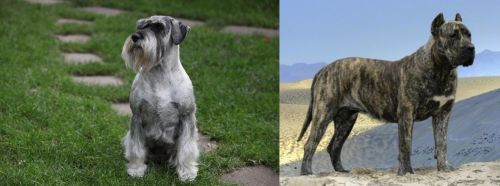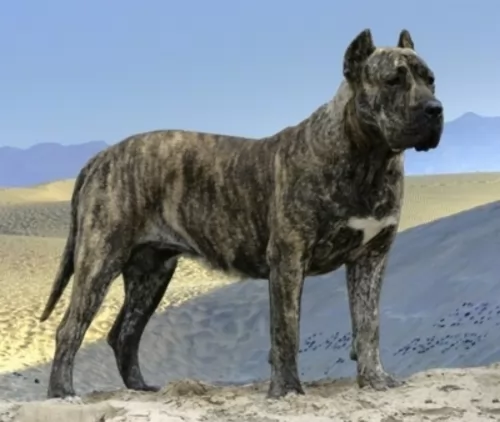 MyDogBreeds
MyDogBreeds Standard Schnauzer is originated from Germany but Presa Canario is originated from Spain. Standard Schnauzer may grow 14 cm / 5 inches shorter than Presa Canario. Standard Schnauzer may weigh 34 kg / 74 pounds lesser than Presa Canario. Standard Schnauzer may live 5 years more than Presa Canario. Standard Schnauzer may have more litter size than Presa Canario. Standard Schnauzer requires High maintenance. But Presa Canario requires Low maintenance
Standard Schnauzer is originated from Germany but Presa Canario is originated from Spain. Standard Schnauzer may grow 14 cm / 5 inches shorter than Presa Canario. Standard Schnauzer may weigh 34 kg / 74 pounds lesser than Presa Canario. Standard Schnauzer may live 5 years more than Presa Canario. Standard Schnauzer may have more litter size than Presa Canario. Standard Schnauzer requires High maintenance. But Presa Canario requires Low maintenance
 Coming out of Germany in the 14th and 15th century is the Standard Schnauzer or Mittelschnauzer. Both the Giant Schnauzer and Miniature Schnauzer are descendants of the Standard Schnauzer. The first name for this breed was the Wire-haired Pinscher until 1879. The breed is a working breed that is popular in Europe and was first in a dog show in 1879 in Hanover, Germany. In 1997 they won Best in Show at the Westminster Kennel Club in New York.
Coming out of Germany in the 14th and 15th century is the Standard Schnauzer or Mittelschnauzer. Both the Giant Schnauzer and Miniature Schnauzer are descendants of the Standard Schnauzer. The first name for this breed was the Wire-haired Pinscher until 1879. The breed is a working breed that is popular in Europe and was first in a dog show in 1879 in Hanover, Germany. In 1997 they won Best in Show at the Westminster Kennel Club in New York.
These medium size Schnauzers were bred in the Middle Ages to be versatile in working and herding in Germany. There seems to be artwork from the 14th through the 16th centuries featuring this breed of dog as a hunter. It is believed that the common ancestors of the Standard Schnauzer is the German Pinscher and the gray Wolf Spitz, along with the black German Poodle and the Bolognese.
It was 1850 when the breed gained recognition as a purebred with distinct and recognizable features. Those are not all the same features that the dogs of today show. These dogs had thick hair on their face, a double coat that is wiry, and their tails were cropped. These dogs were initially Wire-haired German Pinscher then in 1879, a dog named Schnauzer won Best in Show in Hanover. By 1900, the breed was being called Schnauzer everywhere.
The first breed standard was written under the Wire-haired German Pinscher name in the early 1880’s. This standard allowed for a lot of different colors, but the salt and pepper of today was not introduced until the late 1800’s. Then the standard was rewritten in 1907 for the Standard Schnauzer with this as the dominant color.
The first official Standard Schnauzer imported to the United States came in 1905 even though there is a claim that one competed in the 1899 Westminster Kennel Club in the Miscellaneous Class. Following the first World War, the breed became increasingly popular in the States. At that time the US club was called the Wire-haired Pinscher Club of America in 1925. Both standard and miniature sized schnauzer are included in this club.
The breeds were separated in 1933 and became the Standard Schnauzer Club of America and classified by the American Kennel Club as part of the Working Group. In 1926 they moved the Standard Schnauzer to the Terrier Group. By 1926 the Schnauzer Club of Great Britain was formed.
 Known also as the Canary Mastiff, the Presa Canario hails from the Canary Islands. He was originally bred for guarding livestock.
Known also as the Canary Mastiff, the Presa Canario hails from the Canary Islands. He was originally bred for guarding livestock.
This isn’t a new breed by any means, and it is believed that the dog dates back to the 15th and 16th centuries. The roots of the dog can be traced back to the Iberian Presa, a medium sized mastiff breed. A number of other Hispanic breeds have contributed to the formation of the Presa Canario, such as the Presa Espanol.
Its numbers have dropped over the years, but in the 1970s, reputable breeders bred Presa Canarios, a courageous, territorial dog.
Because of its aggressive tendencies, the dog has been banned from quite a few countries. It is found in the USA but not recognized by the American Kennel Club.
 Today’s Standard Schnauzer is a square, robust, medium sized dog. The breed boasts heavy eyebrows and thick beards. They are salt and pepper or black and their coat is wiry and stiff. The breed have excellent muscle tone and a body in proportion height to length. Their build is rugged, and coat is dense.
Today’s Standard Schnauzer is a square, robust, medium sized dog. The breed boasts heavy eyebrows and thick beards. They are salt and pepper or black and their coat is wiry and stiff. The breed have excellent muscle tone and a body in proportion height to length. Their build is rugged, and coat is dense.
 The Presa Canario is a large Molosser-type dog breed originally bred for working livestock.He stands at between 56 to 65cm in height and weighs between 38 and 60kg. He has a thick, muscular body with a black mask over the broad head.
The Presa Canario is a large Molosser-type dog breed originally bred for working livestock.He stands at between 56 to 65cm in height and weighs between 38 and 60kg. He has a thick, muscular body with a black mask over the broad head.
The ears were always cropped which just added to his aggressive appearance. When left they are high set and floppy, being of medium length. The coat is short and coarse and he is a low shedder. The coat comes in colors such as fawn, tan, or brindle.
Strong willed, confident and determined, the Presa Canario may well have an intimidating look.He looks both powerful and even a bit aggressive, but with training and socialization, the highly intelligent Presa Canario is actually a calm, docile dog, totally loyal and loving with his human family.
These dogs are suspicious of strangers and this makes them excellent watchdogs. For new dog owners, the Presa Canario isn’t a good first choice as he is strong-willed and can be aggressive when in the wrong hands. There are however, always exceptions, but he isn't considered to be a good choice of dog when there are children in the home.
 The Presa Canario is a formidable looking dog and has received quite a lot of negative media attention for being aggressive and dangerous. And yet non-aggressive owners who have brought the dog up properly tell of how well mannered and calm their dogs are.
The Presa Canario is a formidable looking dog and has received quite a lot of negative media attention for being aggressive and dangerous. And yet non-aggressive owners who have brought the dog up properly tell of how well mannered and calm their dogs are.
The dog is confident and powerful and can be loyal and loving while also being well adjusted. Just like children are the fruit of their parents upbringing, so dogs turn out much the same as the kind of owners that reared them, and in the right hands, this big dog can be loyal quiet, loving and trustworthy.
 There are a couple of major hereditary health issues faced by the Standard Schnauzer.
There are a couple of major hereditary health issues faced by the Standard Schnauzer.
 These are large dogs so they are susceptible to hip- or joint dysplasia and canine leishmaniasis.
These are large dogs so they are susceptible to hip- or joint dysplasia and canine leishmaniasis.
This is a skeletal condition, found more often in large dogs. The ball and socket don’t fit properly, grinding as opposed to sliding smoothly. This eventually leads to loss of function of the joint.
There are a few factors that lead to the development of hip dysplasia in dogs, but it is also hereditary. That is why it is so important to provide your dog with the correct nutrition – one that is specially formulated for large breeds.
This is a deadly disease caused by a protozoan parasite found in dogs, mostly in rural areas, and in quite a few areas of the world.
The parasite is transmitted by a sand fly. The clinical signs of dogs with this disease include weakness, fever, swollen lymph nodes, anorexia, weight loss and diarrhea with blood in the stools.
Treatment will require the administration of a special drug. Prognosis for a pet diagnosed with Leishmaniasis is unfortunately not very hopeful.
 1Feeding the puppy: At 8-12 weeks feed four times a day. At 3 to 6 months feed three times a day. At 6 to 12 months feed twice a day.
1Feeding the puppy: At 8-12 weeks feed four times a day. At 3 to 6 months feed three times a day. At 6 to 12 months feed twice a day.
4. Games and Exercises – The breed is extremely athletic and needs daily exercise. They are playful with dogs and people and they are family dogs. They want to go wherever you go. Hiking, running, jogging and organized activities.
They are great at obedience, agility, flyball, disc dog, herding and tracking. They have also been involved in search and rescue, bomb detection, and cancer detection.
 The Presa Canario will require being brushed twice a week to rid him of loose hair although he isn’t a heavy shedder.
The Presa Canario will require being brushed twice a week to rid him of loose hair although he isn’t a heavy shedder.
Keep his nails trimmed.
Check inside his ears for signs of redness and the possibility of an ear infection.
When you brush him, check him over for any unusual lumps.
Make sure the dog is neutered or spayed if you don’t want puppies.
Get your vet to the vet if he shows signs of illness.
Make sure his vaccines are up to date to prevent some deadly canine diseases.
Ensure he has a nice comfortable, dry, warm place to sleep.
Ensure he has a top quality diet to enhance longevity and health. Commercially manufactured dog foods are a convenient means to feed your pet, and there are some excellent brands. Avoid the ones with low quality ingredients that don’t have the right balances of vitamins and minerals.
High quality dry kibble can become exciting when you add in some home-made food. Dogs thrive on simplicity, so boiled chicken, sweet potatoes, brown rice or pasta, carrots and spinach will be 100% sufficient for him. Chop this food up and add it into the dry kibble twice a week as a tasty treat.
Also, your pet will thrive on a bit of raw meat added in from time to time. Make sure he is never without a constant supply of fresh, cool water.
Make sure that your large pet gets a good quota of daily exercise outdoors. Lots of hectic ball- and rope games will keep him happy and keep him slim. Take him for a walk every day.